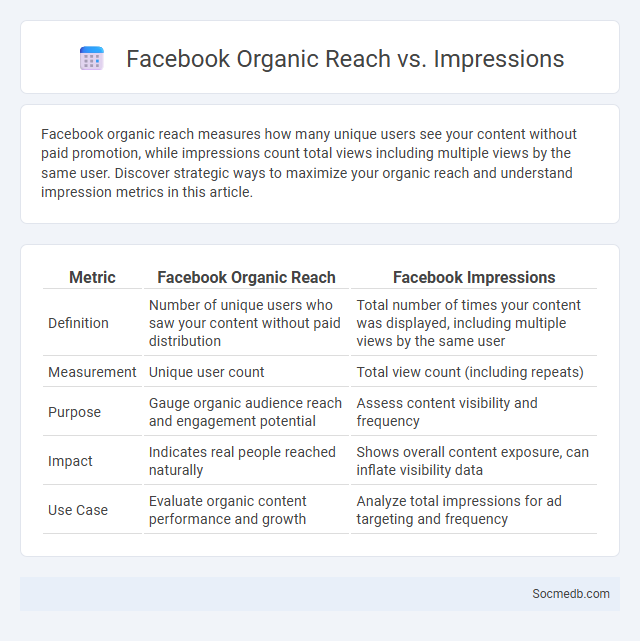
Photo illustration: Facebook Organic Reach vs Impressions
Facebook organic reach measures how many unique users see your content without paid promotion, while impressions count total views including multiple views by the same user. Discover strategic ways to maximize your organic reach and understand impression metrics in this article.
Table of Comparison
| Metric | Facebook Organic Reach | Facebook Impressions |
|---|---|---|
| Definition | Number of unique users who saw your content without paid distribution | Total number of times your content was displayed, including multiple views by the same user |
| Measurement | Unique user count | Total view count (including repeats) |
| Purpose | Gauge organic audience reach and engagement potential | Assess content visibility and frequency |
| Impact | Indicates real people reached naturally | Shows overall content exposure, can inflate visibility data |
| Use Case | Evaluate organic content performance and growth | Analyze total impressions for ad targeting and frequency |
Understanding Facebook Organic Reach: Definition and Importance
Facebook organic reach refers to the number of unique users who see your content without paid promotion, highlighting the platform's algorithm-driven visibility based on engagement and relevance. Understanding this metric is crucial for maximizing your brand's exposure and fostering genuine connections with your audience. Optimizing content for organic reach involves creating engaging posts that resonate with your target demographic to enhance visibility and interaction naturally.
What Are Facebook Impressions? Explained
Facebook impressions represent the total number of times your content is displayed on users' screens, regardless of engagement or clicks. This metric helps track the reach and visibility of your posts, ads, or pages across the platform. Understanding Facebook impressions allows you to gauge how often your audience is exposed to your message, enhancing your marketing strategy.
Key Differences Between Facebook Reach and Impressions
Facebook Reach measures the total number of unique users who see your content, indicating how many distinct individuals engage with a post, while Impressions count the total number of times the post is displayed, including multiple views by the same user. Reach helps gauge audience size and potential engagement breadth, whereas Impressions reveal content frequency and visibility intensity. Analyzing both metrics enables marketers to optimize campaign effectiveness by balancing exposure with audience saturation.
How Facebook Organic Reach Works in 2024
Facebook's organic reach in 2024 is driven by its sophisticated algorithm prioritizing meaningful interactions, relevance, and content quality. Your posts are shown to a smaller percentage of followers, emphasizing engagement metrics like comments, shares, and reactions to boost visibility. Understanding Facebook's emphasis on user preferences and timely content helps maximize your organic reach effectively.
Factors Influencing Organic Reach on Facebook
Facebook's organic reach is primarily influenced by factors such as user engagement, post relevance, and content type. High-quality, interactive content like videos and images tends to receive more visibility due to Facebook's algorithm prioritizing user interest and interactions. Consistent posting schedules and audience targeting also play crucial roles in maximizing organic reach on the platform.
Why Organic Reach Matters for Your Facebook Strategy
Organic reach on Facebook is crucial for building authentic connections with your audience without relying on paid ads, enhancing trust and brand loyalty. It drives higher engagement rates as users interact more genuinely with content that appears naturally in their feeds. Maximizing organic reach also improves algorithm favorability, increasing the visibility of future posts and expanding your overall audience reach.
Measuring and Analyzing Facebook Impressions
Measuring Facebook impressions involves tracking the number of times posts appear on users' screens, providing valuable insights into brand visibility and content reach. Analyzing data from Facebook Insights allows marketers to evaluate engagement rates, identify peak posting times, and optimize content strategy based on audience behavior patterns. Leveraging impression metrics alongside click-through rates and conversion data enhances the effectiveness of social media campaigns and drives targeted marketing outcomes.
Tips to Boost Your Organic Reach on Facebook
To boost your organic reach on Facebook, prioritize posting high-quality, engaging content tailored to your target audience's interests and behaviors. Utilize Facebook's native features such as stories, live videos, and polls to increase interaction and visibility within your network. Consistently engage with followers through timely responses and by encouraging comments to enhance algorithmic favorability and foster community growth.
Common Misconceptions About Reach vs Impressions
Reach represents the total number of unique users who see your social media content, while impressions count the total views, including multiple views by the same user. Confusing reach with impressions can lead to overestimating audience size and misinterpreting engagement metrics. Marketers must analyze both metrics to accurately assess campaign effectiveness and optimize content strategy.
Maximizing Engagement: Choosing Between Reach and Impressions
Maximizing engagement on social media requires understanding the distinction between reach and impressions, where reach represents the number of unique users seeing your content, and impressions indicate the total views, including multiple views by the same user. Concentrating on reach helps you expand Your audience base, while prioritizing impressions can reinforce brand messaging through repeated exposure. Tailoring your strategy based on campaign goals ensures optimal interaction and boosts overall social media performance.
 socmedb.com
socmedb.com